
I am Rachel Darlington, living in Bunclody, Co. Wexford. My connection with Kilmore is from the O Flaherty and White lines. Unfortunately I did not inherit any oral tradition of where my family came from so the information I have has had to be slowly and painstakingly gleaned, through the genealogy process. We all start out as amateurs but persistence and application give substantial rewards!
I am pleased to give you a condensed account of my O Flaherty lineage, which severed ties with Kilmore back in 1862. I have not yet traced my White ancestors from Kilmore – it is trickier, there are substantially more people in Kilmore named White than Flaherty.
The initial purpose of this genealogy project was to enable me to trace my White roots, possible only through a comprehensive transcription of all existing records. I also wanted to fill in several gaps, regarding my O Flaherty ancestors. Since I needed to do a transcription exercise for myself anyway, I decided to put the data on the web in the hope that others may also benefit.
Mary Ann O Flaherty 1873-1929
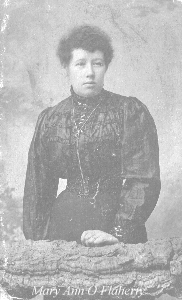
My
great grandmother was Mary Ann O Flaherty. Mary Ann was born in Michael
Street, Wexford Town, in 1873.
Mary Ann was the second youngest of eight children. When she was one year old, the family moved to Britfieldstown, Co Cork, probably due to her father’s work as a lightshipman. The school record for Mary Ann’s brother, William, simply states “removed to Cork”. In any case, Mary Ann’s youngest sister, Helena, was born in Britfieldstown in 1875.
It is uncertain when the Flaherty family returned to Wexford Town but they had returned by 1894, when Mary Ann was bridesmaid at her sister Dora’s wedding.
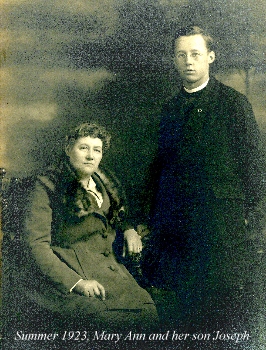 Mary Ann emigrated to Liverpool some time before 1901, where she worked
as a general domestic servant. She may have eventually become housekeeper,
however, as the photo opposite shows her wearing a set of keys.
Mary Ann emigrated to Liverpool some time before 1901, where she worked
as a general domestic servant. She may have eventually become housekeeper,
however, as the photo opposite shows her wearing a set of keys.
At the age of 31 Mary Ann married a sailor, Michael Byrne, also originally from Wexford Town, and the couple settled and had four children in Bootle, Liverpool:
Joseph
Byrne, 1905
Mary Ann Byrne, 1906 (died Liverpool, unmarried)
Johanna Byrne, 1908 (married John Webster, no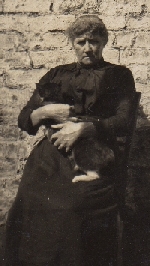 children)
children)
Dora Teresa Byrne, 1909 (died Liverpool, unmarried)
There is some evidence that Mary Ann's sister, Helena, also moved to Liverpool - she was the godparent to Mary Ann's eldest child. In addition, several nephews of Mary Ann's also followed her to Liverpool - children of her eldest brother, William.
I believe the Byrne family regularly visited their relatives in Wexford Town, a tradition which their children continued into later life. In the summer of 1923 Mary Ann Byrne visited her son Joseph, by then a Christian Brother in Dublin, and had their photograph taken at a studio in Dún Laoghaire. It was, no doubt, also an opportunity to visit her sister, Dora, by then living in Dún Laoghaire with her lightshipman husband, Nathaniel Duffy.
Mary Ann Byrne died of bronchitis, son by her side, at her home in Bootle in 1929. She is buried in the Ford Cemetery, Liverpool.
William Flaherty 1837-1918
Mary Ann’s father was William Flaherty. William was born in Kilmore Quay (formerly known as Namestown), Co Wexford, in 1837 to John Flaherty and Catherine White. In 1853 there were three adjacent houses in Namestown in Flaherty hands. William would have lived in the house owned by John, his father.
William was five years old when his mother died (see below) and eight years old when the Great Famine struck. However, Kilmore actually underwent a population increase during the famine, perhaps due to the availability of fish and the nearby Public Works. I will talk about this when I come to talk about William’s father.
William married Dora Butler of Tombrick, Ballycarney, north Wexford, in 1859. The marriage took place in Kilmore and the couple’s first child was born there in 1861. Unfortunately I do not know what Dora had been doing in Kilmore or William in Ballycarney before their 1859 marriage – one of them had certainly been far from home at a time when people did not travel too much.
In 1862 William, Dora and their son, also called William, left Kilmore and moved to Wexford Town. William worked as a Lightshipman and the family lived in the parish of St Michael of Feagh.
Although they frequently moved house (and street) between 1862 and 1873, the family remained in the same parish. Indeed, The Faythe, the street in Wexford town where Dora was to die in 1895, was known as the “Valley of the Wooden Hams”. This title referred to the sailors’ wives’ custom of displaying a wooden ham in the house window. The wooden ham was supposed to demonstrate affluence, especially when sailor husbands were away at sea. The ruse seems, however, to have had limited success, hence the street’s nickname.
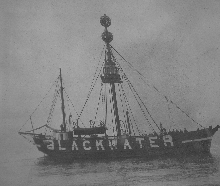 The
following children were born to the Flaherty family:
The
following children were born to the Flaherty family:
William Flaherty, 1861 (master of Blackwater Lightship until 1918)
Mary Teresa Flaherty, 1863
Christina Flaherty, 1864
Dora Teresa Flaherty, 1866 (married Nathaniel Duffy, lightshipman, Dun
Laoghaire)
Elizabeth Flaherty, 1868
John Joseph Flaherty, 1871 (sailor, emigrated US, see his grandson’s
genealogy page)
Mary Ann Flaherty, 1873 (see above)
Helen Flaherty, 1875 (in Liverpool in 1905)
In 1874 the Flaherty family moved to Britfieldstown, Cork, where their last child, Helen, was born. There is also some evidence that the family lived in Portaferry, Co Down, with William stationed at the South Rock lightship.
When in Wexford Town, it is likely that William worked on the Blackwater lightship. Certainly William's son, of the same name, was master of the Blackwater lightship until his death in 1916.
Lightshipmen used to work on a two-week-on, two-week-off basis. They
stayed on the lightship for two weeks and then had two weeks at home.
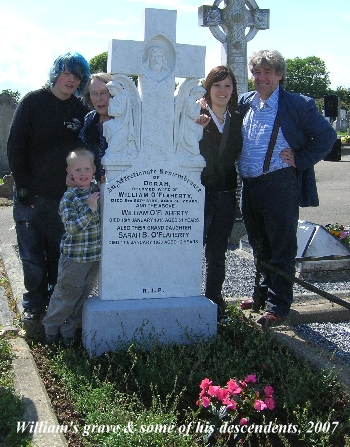 When
the weather was bad, lightshipmen could often not be relieved and had
to stay longer on the ship. Unfortunately they only had enough food
for two weeks so after two weeks, they had to resort to fishing.
When
the weather was bad, lightshipmen could often not be relieved and had
to stay longer on the ship. Unfortunately they only had enough food
for two weeks so after two weeks, they had to resort to fishing.
William Flaherty returned to Wexford Town and retired from the Irish Lights, on a pension, some time before 1895, before the age of 57. In my discussions with the Irish Lights they advised that normal retirement age was 60-65. Retirement before that age would have been due to ill health or disability.
In any case, even if William was suffering ill health, the family was
doing well in 1895. William erected a marble headstone, carved by Italian
craftsmen in Dublin, to his wife, Dora, on her death, and remarried
three years later.
I have been unable to locate William on either the 1901 or 1911 Irish
census so it is not known where William went to live once he married
Jane Clancy, of the Dirr, Taghmon, in 1898.
In 1916, the year of the Easter Rising, both William’s second
wife and his eldest son died. William Flaherty’s life seems to
have taken a downturn after these events. He lived for some time in
South Main Street, Wexford, but then moved to the Wexford Workhouse,
where he died in 1918.
William is buried, with his wife Dora, in the marble, angel-carved grave
in Crosstown Cemetery. Until 2006, there was no inscription for William,
but burial records have allowed his name to be finally inscribed on
the tombstone.
John Flaherty 1802-1877
I know that William’s father was John Flaherty from the civil record of William’s second marriage.
In 1853 the only John Flaherty in Kilmore was living adjacent to Sylvester & Thomas Flaherty in Namestown (The Quay), Kilmore. I speculate that John and Thomas were brothers to Sylvester but I have no proof as I cannot find either of their baptismal records.
Sylvester, however, was born to Edward Flaherty and Catherine White in 1806. Edward Flaherty is the only Flaherty in the Kilmore 1833 Tithe Applotment and he was living in Namestown at that time.
Judging by John Flaherty’s age on his death record, he was born
about 1802. This proves problematic, however, as his supposed brother,
Sylvester, was born in 1806, making John older than Sylvester. It is
problematic because in 1853 John is leasing land from Sylvester.
The fact that John is leasing from Sylvester suggests that Sylvester
is the oldest surviving brother and therefore he inherited their father’s
land.
The legacy of the Penal Laws had persisted through famine times, with
the result that fathers generally divided their land equally among their
sons. After the famine (1845-1850), much of Ireland’s social fabric
had been altered. Indeed, customs had changed to the extent that eldest
sons now inherited any land. Failing the discovery of John’s baptismal
record, it is probable that the age on his death certificate is incorrect
and that John was born after 1806. If so, I hope to eventually find
John’s baptism record through this transcription project.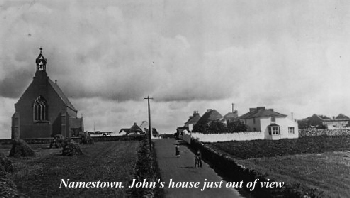
John married Catherine White and had the following children:
Catherine Flaherty, 1829
Edward Flaherty, 1831
Thomas Flaherty, 1833
William Flaherty,1837 (see above)
James Flaherty, 1840
Mary Flaherty, 1841
In 1842, a few months after the birth of their youngest child, John remarried, to Mary Busher. This suggests that Catherine White died in childbirth and John remarried quickly to provide a mother to his infant children. Although the baptimal record has not survived. I believe that John had the following child with Mary Busher:
Elizabeth Flaherty, 1845 (dressmaker, died in Kilmore aged 19)
John’s occupation is noted in surviving documents as farmer or labourer but, given the proximity of the sea and the occupation of his two brothers, I would be surprised if he did not engaged in fishing.
The National Archive in Dublin holds a series of Famine Manifests (petitions) submitted by the people of Kilmore as part of their application for Public Work funds to build a pier at Crossfarnogue. You can read several of these petitions on this website. On one such petition, specified for fishermen and boat owners, we can see John’s signature. John signs alongside his brother, Sylvester and father, Edward.
While Wexford suffered less than other counties during the Great Famine, I conjecture that fishing kept the Flaherty brothers of Kilmore, and their families, alive during that time.
Indeed, in Irish Villages by Karina Holton, Rita Edwards refers to a petition from December 1844, listing fishing boat owners. While I was unable to locate that document myself in the National Archive, Rita Edwards lists “Thomas Flaherty” as owner of the “May-flower” in 1844. I speculate that Thomas Flaherty’s fishing boat enabled himself and his brothers, Sylvester and John, to survive the Famine.
John Flaherty again signed a manifest in 1871. This time, with the rigours of the Famine behind him, he joins with others from the Quay in requesting a Chapel to be built on the Quay.
John Flaherty died of bronchitis in 1877. He may have been survived by his second wife, Mary Busher.
Edward Flaherty circa 1771 - after 1833
Little is known about Edward Flaherty, including his date of birth and death. What is known is that Edward lived in interesting times.
 Born
at a time when the Penal Laws were losing their hold in Ireland, Edward
would still have had to attend a Hedge School, along with other catholic
children. We know from one surviving sample of his signature that Edward
was able to write - perhaps something more than just his name, judging
from the fluency of his lettering. We also know, from a manifest, that
Edward was a fisherman.
Born
at a time when the Penal Laws were losing their hold in Ireland, Edward
would still have had to attend a Hedge School, along with other catholic
children. We know from one surviving sample of his signature that Edward
was able to write - perhaps something more than just his name, judging
from the fluency of his lettering. We also know, from a manifest, that
Edward was a fisherman.
It seems that Edward was already married and having children at the time of the 1798 Rebellion. It is therefore unlikely that he took part in the uprising or the Battle of Ross, where several Kilmore men died. Generally speaking, younger, unmarried men were the ones who carried their pikes, in the name of the Rebellion.
Edward married Catherine White sometime before 1799 and his first son seems to have been James. This suggests that Edward’s father may have been James too but research does not bear this out.
Having comleted the transcription of the parish records from 1752-1785 and not finding Edward's birth, it is unlikely that Edward Flaherty was the son of James (the only male Flaherty having children in Kilmore at the time). If Edward was born to James then he was born before 1752, making him 64 when he had his last child and 81 during the Tithe Applotment. Edward's wife, Catherine White, was not born in Kilmore between 1752 & 1785 either and, as it would have been impossible for her to bear a child at the age of 64, she must have come from outside the parish. It is likely that Edward came from outside the parish too.
Edward Flaherty and Catherine White lived in Kilmore and had the following children:
Thomas Flaherty, 1799 (no birth record found, living beside John &
Sylvester in 1853, died 1865, may have had Power descendents in Crossfarnogue)
James Flaherty, 1799or1800 (very illegible baptismal register and missing
dates)
John Flaherty 1802-1808 (no birth record found, see above)
Mary Ann Flaherty, 1804
Sylvester Flaherty, 1806 (fisherman, died 1889, Flaherty descendents
still living in Kilmore)
Elizabeth Flaherty, 1810 (died 1865, unmarried)
Edward Flaherty, 1813 (mariner, unmarried 1871 census)
William Flaherty, 1816 (may have had Hegan descendents in Kilmore)
We can see from the Tithe Applotment that in 1833 Edward is living in Namestown and is the only Flaherty head of household. He died sometime between 1833 and the Griffith Valuation of 1853.
James Flaherty born circa 1733
James Flaherty is unlikely to be the father of Edward Flaherty and is, therefore not my ancestor. He is the only Flaherty male, having children in Kilmore between 1752 and 1770. He would have been born around 1733 but where did he come from?
James is not the only Flaherty in Kilmore, between these dates, therefore this suggests that he was not the first to arrive in the parish.
A Mary & Catherine Flaherty of Kilmore make appearances as godparents in 1763 & 1766 and a Matthew Flaherty of Kilmore, died there in 1765.
There is also a Johanna Flaherty of Kilmore, married to Nicholas Parle, who had children in Kilmore in 1754 & 1768. Johanna may have come from the neighbouring parish of Ishartmon, however, as the godparent to her second child, Thomas Flaherty, came from Ishartmon.
Likewise, an Ambrose Flaherty married in Kilmore in 1765. Ambrose, bizarrely, came from neighbouring Ambrosetown and was marrying Johanna White of Mulrankin. It seems that the tradition of marrying in the bride’s townland brought Ambrose to Kilmore but the couple went to live in his parish of Ambrosetown.
Whether James Flaherty was born in Kilmore or came from Ambrosetown or Ishartmon, it must be noted that Flaherty is not a Wexford name. O Flaherty is a name that hales from the west, from Galway and in 1853 there was only a handful of Flaherty households in the whole of Wexford.
One story claims that a branch of O Flaherty may have escaped from Cromwell, travelling in the opposite direction of his “Hell or Connaught” edict and arriving in Wexford. Another story has people fleeing from Connaught by boat and, travelling around the Irish Coast, they arrived in Kilmore. And the reason for flight? If not to escape Cromwell then perhaps to escape famine – until the Great Famine of 1845, the famine of 1741 was known in folk memory as Bliadhain an áir (year of the slaughter).
Whatever the reason for flight, there was an O Flaherty presence in Kilmore from the oldest surviving records of 1752.
James Flaherty married Catherine Power some time before 1752 and had the following children:
Anistacia Flaherty, born 1753
Mary Flaherty, born 1755
Sylvester Flaherty, born 1756 (may have married Bridget Kelly)
Thomas Flaherty, born 1761
Anistacia Flaherty, born 1763
Catherine Flaherty, born 1766 (presumed to have died)
Catherine Flaherty, born 1768 (may have married John Cleary and lived
in Kilmore)
As previously mentioned, Edward does not seem to have been James' son.
No record of the death of James, or his wife, has been found to date
but James was still alive in 1781 when he was sponsor at a wedding.
* * *
A debt of thanks is due to the many people far and near who have assisted
and inspired in this project, especially to David Robertson in Dublin,
my uncle John in Stockport, Colette Merriman my second cousin once removed
in Waterford, Séamus O'Flaherty and my other fifth cousins in
Kilmore Quay, and Jack Rand second cousin once removed, in the USA.
And a big thank-you to my husband Norman Darlington, for creating this
website.